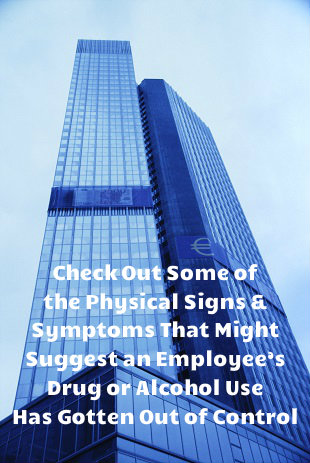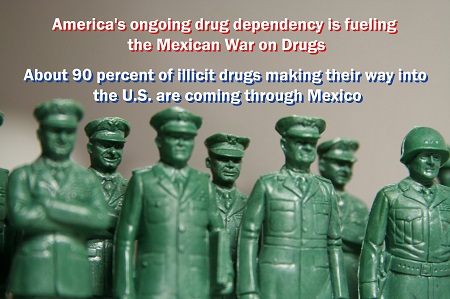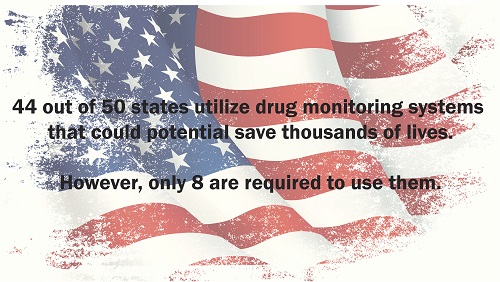Searching for the ultimate high, teens share drugs, mix drugs and succumb to the ill after-effects that drugs impose on them. They are often smart enough to know that the drug will make them feel awful after the high has worn away, but addiction doesn’t respond well to this reasoning. To truly break a drug addiction, teens need professional guidance and treatment.

Courtesy of: www.pentagonpost.com
Molly, also known as ecstasy or MDMA, promises teens an exhilarating feeling. In an NBC news report, one young man said that he was lured by the intense high that Molly gave him. He was looking for something new and someone suggested to him that Molly was like a new form of the drug ecstasy.
MDMA’s Short High And Dangerous Side-effects
His first encounters with Molly made him feel great. He said that the drug made him feel very happy and excited. He felt on top of the world and it was exactly what he was looking for. But the happiness didn’t last long and the young man soon realized that the short time he was high came with a long sentence of feeling completely worn out, both physically and mentally.
When teens search for a great high, they don’t think about the ill effects the drug may cause. Part of that comes from living in the moment and not worrying about the consequences. Some might even say the consequences are worth it. But over time, the consequences get more intense, and like a wheel racing downhill they can’t find a way to stop, event when the consequences become too overwhelming and change their life for the worst.
When self-esteem plummets and fatigue becomes overwhelming, some teens may try to stop using by themselves. Molly causes withdrawal symptoms like heavy sweating, overheating, high blood pressure, extreme dehydration and in some cases death. It can also affect teens psychologically, sometimes causing short term psychosis.
How Addiction To Molly Takes You To A New Low
The young man who was interviewed by NBC said that he knew he was letting Molly control him when he started selling his child’s toys in order to get money for drugs. He could not believe the person that he had become and how his need for the drug had changed him so much. He had also been lured by the media, knowing that popular movie stars and musicians were using the drug.
Recovery From The Lows Of Molly
The only way he was able to break free from Molly was through a treatment center that guided him back into better mental and physical health. Through his experience he cautions teens to stay away from the lure of that high that inevitably and impersonally drops you off into the lowest low.
For nearly a quarter century now the state of Indiana has been conducting a youth substance use survey. The data is used to direct prevention and intervention strategies and to gauge how well those efforts are working. The most recent annual survey of alcohol, tobacco and other drug use, the Indiana Youth Survey 2013, reflects current trends in teen behaviors and attitudes and shows that some interventions are proving successful.
 The survey questioned 117,554 teens from private and public schools attending grades six through senior in high school. The survey is conducted in conjunction with the Indiana Prevention Resource Center who makes resources available to schools and communities aimed at curbing teen substance abuse.
The survey questioned 117,554 teens from private and public schools attending grades six through senior in high school. The survey is conducted in conjunction with the Indiana Prevention Resource Center who makes resources available to schools and communities aimed at curbing teen substance abuse.
Use of marijuana by teens (12 to 17 years) hit an all-time high in the state between 2008 and 2011. The good news is that the most recent survey shows that marijuana use is now falling among teens there. However, while marijuana use is dropping, its use is still seen as too high, and synthetic marijuana use is an increasing concern.
Synthetic Marijuana Use Dangerously Increasing
Synthetic marijuana is just what it sounds like — a man-made substance that mimics marijuana. It is made by drying plant material and then spraying it with chemicals which mirror the effects of marijuana and THC. The plant material is then chopped and marketed in stores as incense, but kids roll it and smoke it just like natural marijuana. In fact, the survey shows that teens are not substituting fake marijuana for real marijuana but are using the two drugs simultaneously.
This year’s survey included new questions related to risk factors and protective factors that influence teen drug use. Questions pertaining to the health of relationships and attitudes reveal the degree of risk or protection teens are experiencing. The attitudes of parents and friends about drug use influences teens greatly, as do how well relationships at home, school and among peers are faring.
Prescription Drug Abuse
The survey found that prescription drug abuse increases with age. Less than two percent of sixth graders reported abusing prescription drugs, but more than 14 percent of seniors admitted using. The survey was specific in asking teens if they bought prescription drugs from friends or obtained them from family members. Since a major protective factor against prescription drug abuse is a teen’s perception of danger, the survey highlights the need for more information and better education strategies letting kids know just how dangerous misuse of prescription drugs can be.
Other news found in this year’s survey included success in lowering the numbers of teens who engage in gambling (online, lottery, slot machines etc.). Teen gambling rates have dropped in Indiana and the survey revealed that teen regret/remorse over gambling is increasing.
Drugs and alcohol extract a heavy toll on those who are close to a person with a substance abuse problem. But they can also cause great difficulties in the workplace, where the reliability and on-the-job performance of addicts will inevitably decline over time. In the American economy, lost productivity related to substance abuse is estimated to add up to hundreds of billions of dollars annually, and, for individual businesses attempting to survive on marginal profits in a sluggish economy, it is especially vital to have employees who can be counted on in a pinch.
 But despite all that is at stake, employers should recognize that addiction is a disease and not simply an irresponsible lifestyle choice, and workers who are suffering from the effects of a substance abuse problem should be treated with compassion and respect as long as they are willing to be open and truthful about what is happening in their lives.
But despite all that is at stake, employers should recognize that addiction is a disease and not simply an irresponsible lifestyle choice, and workers who are suffering from the effects of a substance abuse problem should be treated with compassion and respect as long as they are willing to be open and truthful about what is happening in their lives.
Managers may be able to evaluate the performance of their workers accurately, but it is of course extremely difficult to ascertain why a formerly productive and judicious employee has begun to falter on the job. People often have hidden personal problems or various types of health troubles that can negatively impact their workplace efficiency, either temporarily or permanently, so it is important that bosses and managers tread lightly when they seek to discover the reason a reliable employee has suddenly been giving a less-than-stellar effort or failing to produce results.
Recognizing The Signs
When substance abuse is the problem, there will be indicators that can help clue employers in to what has been going on. It may take a sharp eye to spot them, but they will be present.
Some of the physical signs or symptoms that might suggest an employee’s drug or alcohol use has gotten out of control could include:
- Bloodshot eyes
- Nosebleeds
- Unexplained weight loss and loss of appetite
- Dental problems
- Slovenly or unprofessional appearance
- The presence of unusual odors on or around the employee
- Slurred speech
- Sleeping on the job
- Shaking or tremors
- Seizures
In addition to these tell-tale physical symptoms, the behavior of addicts or alcoholics will likely change in noticeable ways as well. Some behaviors to look out for would include:
- Frequent tardiness
- Mood swings, fits of irrational anger, or sudden bouts of hyperactivity
- Secretiveness
- Sloppiness in carrying out routine assignments
- Refusal to spend time with co-workers during lunch hours or in off-hours (when this activity had been normal before)
- Loss of interest in favorite hobbies or activities
- Actions or choices that lead to injuries or accidents on or off the job, with hazy explanations about what took place and exactly why it happened
Above all else, when the issue is substance abuse, employers and co-workers should learn to trust their instincts. Because substance abuse is so common, most of us have likely encountered it in our families or among friends at some point in our lives, and consequently we are usually capable of recognizing the signs of substance abuse.
The Value Of Preparation
It is always better to anticipate trouble before it arrives so you will be prepared to handle it if and when it comes. This is certainly true when the subject is substance abuse in the workplace, and that is why all employers should have clearly established policies that dictate how addiction and problem drinking or drug abuse will be handled. These policies should be fully disclosed and explained succinctly in written form, in a document or handbook that will be considered required reading for all employees. And just to make sure there is no confusion or uncertainly, employees should be required to a sign a form indicating that they understand the company’s substance abuse policies and will accept any and all consequences of their actions.
But while employers have some leeway in this area, they cannot dictate automatic dismissal if a substance abuse problem is proven to exist. Federal and state disability laws protect the rights of workers with drug or alcohol addictions if they are willing to seek treatment for their dependency, and it is incumbent upon a business owner or manager to speak with a company attorney before instituting substance abuse policies to make sure everything is strictly legal and in synch with existing civil rights statutes.
Employers must be ready, willing, and able to help their workers get the assistance they need should substance abuse become an issue. To make sure they are prepared to do so, businesses should have insurance policies that will cover the costs of drug/alcohol treatment and rehabilitation for workers should they ever be required. Of course managers themselves could someday encounter substance abuse problems, which means that it is really in everyone’s best interests to have adequate health insurance to cover this contingency. And just so they are sure what is out there, employers should fully research drug and alcohol treatment options available in their communities, so that if and when employees need this information it will be available and accessible.
Asking The Right Questions, Getting The Right Answers
When substance abuse is suspected, an employer should approach his or her employee in a way that is open and honest but not confrontational. This is the best way to get answers, and it is the most compassionate path to take when the issue is a disease like addiction. Nevertheless, managers and bosses have a need and a right to discover the truth from their employees about what is happening when workplace performance is suffering, and if an employer cannot get a straightforward response from a worker who is failing to do his job correctly, termination will be a legally permitted option.
But the ultimate goal of any workplace intervention should be to help the person in question get the help he or she needs. With hard work, determination, and a relentlessly positive attitude, addiction can be overcome, and it is in the best interest of every employer to offer whatever assistance they can to men and women whose lives have been momentarily sidetracked by drug or alcohol dependency.
To Read About the Drugs Students are Taking to Boost Grades – Click Here
Pain medications are often prescribed for chronic pain related to other medical conditions, such as cancer or an injury that results in ongoing pain. In all cases, the prescription of a pain medication to relieve pain must be weighed against the potential negative consequences of using such a medication, including not only side effects but also the risk of addiction.
In addition, the pain is best managed when there are follow-ups to the prescription that include assessments of pain levels and examination of co morbid conditions. In a recent study, researchers led by Leslie R.M. Hausmann, PhD of the Veterans Affairs Pittsburgh Healthcare System and Assistant Professor of Medicine at the University of Pittsburgh discovered that there are significant disparities between races in how pain management is executed.
The researchers found that the differences are present in the monitoring of opiods and in the follow-up routines. The recommended guidelines include assessing patients for the effectiveness of the medication, as well as screening them for evidence of drug abuse. The study’s findings appear in a recent issue of the journal PAIN.
The study’s focus included several measurements of pain management defectiveness, including the physicians’ implementation of an opioid agreement, measurement of pain levels at follow-up exams, inclusion of urine screenings for drugs and referrals for pain clinics and substance abuse treatment.
The retrospective design incorporated health records representing 1,646 white patients and 253 black patients. The data was taken from electronic health records that met certain criteria. The patients were all prescribed opioids for pain not related to cancer at the Veterans Affairs Pittsburgh Healthcare System pharmacy and used the medication for at least 90 days. The records were all from October 2007 to September 2009.
The researchers also assessed data about prescription painkiller follow-up and monitoring practices for the 12 months following the prescription period, to form a complete profile of the pain treatment.
The patients were 94 percent male and 22 percent were over the age of 65. Forty-five percent were married or living with a partner, and were most commonly treated for joint or back pain. Approximately one half of the patients had a co morbid mental or physical health condition, and one-third of the patients had a past of substance abuse.
 When comparing the patients, the black patients were younger, less liable to have pain in their back, and had more physical co morbidity and higher pain levels recorded. The black and white patients were similar in history of drug abuse.
When comparing the patients, the black patients were younger, less liable to have pain in their back, and had more physical co morbidity and higher pain levels recorded. The black and white patients were similar in history of drug abuse.
However, major racial differences were discovered as pertained to monitoring of pain prescription use and the effectiveness of the medication. Black patients seemed less likely to be monitored for pain levels during medical exams and among those patients given a urinalysis, black patients were tested more often, and particularly if they were prescribed a higher dose of medication.
Black patients also were less liable to receive a referral to a specialist for pain treatment and were more likely referred to a substance abuse treatment facility after taking prescription opioids.
The findings indicate that when black patients are prescribed opioid medications for pain treatment, they may not be receiving similar follow-up and monitoring practices that may maximize the benefit of their pain management treatment.
Read more about Dispelling Racial and Socioeconomic Myths About Drug Users
Many state legislatures have enacted laws to make it easier for them to establish a prescription database to track drug abuse. These programs are often put in place to assist law enforcement in cracking down on illegal activity such as producing methamphetamine. Clandestine laboratories rely on large amounts of cold medicine to produce their dangerous substances that wreck lives. Most of that activity has been squelched by drug monitoring programs; another advantage to these programs affects more than just law enforcement.
The monitoring programs also help point the way to users who are likely abusing a prescription drug, which can lead interventions that are potentially life saving. These programs, which are now up and running in 44 states, have proven to be an invaluable tool for healthcare providers. They are now able to legally monitor the frequency of prescription drug use among their patients. The drugs being monitored include opioids, amphetamines and sedatives. But laws vary per state and only eight states currently require providers to participate in the monitoring programs.
What is certain is that the states that do allow a monitoring program have less of a problem with the current epidemic of pain killer abuse in this country. While not much is known about how the monitoring programs are affecting the way doctors prescribe their drugs, one study done in Ohio shows that more than 40 percent of emergency room doctors who had access to their patient’s prescription drug history made different prescription decisions based on the data from the monitoring program.
Almost all physicians are pressed for time, which means their ability to thoroughly study the data available to them is hampered. Furthermore, the amount of resources available to healthcare professionals to fully interpret the data providing by monitoring programs is also in short supply, limiting the impact that the data could have on the health of patients across the nation.
Reporting the news in Mexico can be a deadly occupation, especially for those covering the drug war. But where militant thugs have been successful in stifling the media, they are virtually powerless against those who have taken to social media to “report” the war.
It’s not only Mexican residents caught in the crossfire taking to Twitter, YouTube and Facebook, those across the border in the U.S. are also using social media as a tool. Residents are using social media to protect themselves from the drug cartels that stop at nothing to push their product and protect their turf.
 The violence began in earnest when the Mexican president declared war on drugs, but crept up another few notches when two major partnering cartels split and declared war on each other. Since the declarations of war, it is estimated that as many as 100,000 people have been killed and another 30,000 have seemingly vanished into thin air. Many residents try to escape the most violent areas, which has put more than 200,000 in a displaced status.
The violence began in earnest when the Mexican president declared war on drugs, but crept up another few notches when two major partnering cartels split and declared war on each other. Since the declarations of war, it is estimated that as many as 100,000 people have been killed and another 30,000 have seemingly vanished into thin air. Many residents try to escape the most violent areas, which has put more than 200,000 in a displaced status.
Some of the only news sources available now are through Twitter and Facebook. While news footage once came from the major broadcast companies in Mexico, camera phones with crudely edited footage of the war between the government and the cartels is being placed on YouTube instead. Media outlets in the U.S. are also depending on these amateur videos as their go-to source for footage.
America’s ongoing drug dependency is fueling this war. About 90 percent of illicit drugs making their way into the U.S. are coming through Mexico. The biggest cash crop, so to speak, continues to be cocaine.
According to the National Institute on Drug Abuse, nearly 5 million Americans said they had at one point or other abused cocaine. While those numbers pale in comparison to the drug’s peak in 1982 (10.5 million were believed to be using the drug in that year), it’s still enough to fuel a drug war that is taking lives.
Read more: United Nations Leading International War on Drugs
Curbing drug use isn’t something that can be solely dealt with at a national level. Effective policies must be put in place on a global scale. In 2010, approximately 5 percent of people all over the world, or 230 million individuals, admitted to engaging in illegal drug use at least once.
 The United Nations Office on Drugs and Crime (UNODC) has been working since 1961 to control drug use in order to preserve public health and welfare. Each year, illegal drugs claim the lives of around 200,000 people. So many of these individuals might not have had to die had they received the help they needed.
The United Nations Office on Drugs and Crime (UNODC) has been working since 1961 to control drug use in order to preserve public health and welfare. Each year, illegal drugs claim the lives of around 200,000 people. So many of these individuals might not have had to die had they received the help they needed.
Since its inception, the organization has made an effort to combat this issue not only with law enforcement, but also with policies that would address the deeper core issues of health and addiction.
According to Reuters, the UNODC global drug conventions that took place in 1961, 1971 and 1988 have helped standardize the world’s drug regulation policies, reducing the proliferation of illegal drugs. In fact, even as the world’s population has continued to multiply over the last hundred years, global production of opium, for instance, has decreased by 80 percent.
Many individuals addicted to drugs are sick and do not belong in a prison with hardcore criminals. While there are those who would say that legalizing drugs is the answer to combat the international drug problem, proponents of the UNODC efforts say that current measures are working.
But for these measures to continue being effective, countries around the world must offer education, rehabilitation, and social reintegration programs to drug offenders rather than prison sentences. Receiving these individuals as patients instead of criminals presents the greatest opportunity for change so that everyone has the chance to lead a healthy life free from drugs and crime.
Drugs available in your backyard? Teens say drugs easy to get their hands on in New Mexico.
17 Jun 2013
Molly – An Unsuspecting Name for a Potent Drug
Taking the good with the bad is a life lesson that everyone learns at some point. But young people involved in the rave culture are finding that drugs bringing on extremely intense feelings of pleasure have an equally displeasing depressing effect.
The drug, Molly, has a name that sounds innocent enough, but unsuspecting users are devastated by the crash they experience when coming off the high. In some cases, the depressing feelings lead to a near paralyzing state where the user can’t find the mental strength to eat or communicate.
The intense emotional ride and the relatively cheap cost of that ride are helping push the popularity of Molly further every day. The drug is actually the powder or crystal form of MDMA (AKA Ecstasy). The popular drug Ecstasy is actually derived from a variety of drugs, not just MDMA. Molly is a purer form of Ecstasy and actually gets its name from “molecule,” which is representative of its place as the vital ingredient to MDMA.
The DEA has classified Molly as a Schedule I controlled substance due to its addictive nature and because it has not been embraced by the medical community as having any usable characteristics in health care.
Users who take too much of the drug will have a difficult time with temperature regulation and can actually experience hyperthermia, which can lead to liver, cardiovascular and kidney failure.
The current statistics from emergency rooms across the nation don’t indicate that the use of this drug is widespread yet. But the massive growth in its popularity in such a short time has experts concerned – there was an approximate 125 percent growth in the use of the drug between 2004 and 2009.
Continue reading: Understanding the Effects of Substituted Amphetamines



